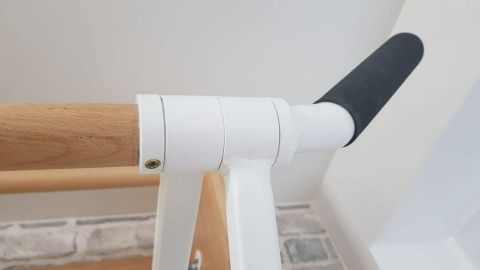Fitness & Wallbars
Looking for top-quality fitness equipment? Our Fitness & Wallbars collection includes a number of products to help you achieve your fitness goals. Our Swedish Ladder, also known as wall bars, are ideal for fitness and gymnastic training. Made from metal and wood, these wall bars are both sturdy and reliable. Whether you're a novice or an expert, we have the perfect products to enhance your fitness experience.
Transform your workout with our wallbars - the ultimate piece of versatile workout equipment. Made from high quality wood, they are built to last and suitable for use in both home and commercial gyms. Our wallbars can be used for a range of exercises, helping you to target different muscle groups and improve your overall fitness. Order online today and experience the difference for yourself.
In the ever-evolving world of fitness, one trend that has stood the test of time is the use of wallbars. These simple yet highly versatile pieces of equipment have been a staple in gyms and fitness studios for decades. In this comprehensive guide, we will delve into the world of fitness and wallbars, exploring their history, benefits, exercises, and how you can incorporate them into your fitness routine.
History of Wallbars
Wallbars, also known as Swedish bars or stall bars, have a rich history dating back to the 19th century. They were originally designed by Per Henrik Ling, a Swedish physical therapist and father of Swedish massage. Ling developed these bars as a tool for therapeutic exercises and rehabilitation. Over time, their use expanded beyond rehabilitation to encompass general fitness and strength training.
Benefits of Wallbars
-
Versatility: Wallbars offer a wide range of exercise possibilities. You can perform various bodyweight exercises, stretches, and mobility drills using this simple piece of equipment.
-
Space-Efficiency: Wallbars are wall-mounted, making them ideal for home gyms or spaces with limited room. They take up very little floor space while providing a multitude of exercise options.
-
Strength and Flexibility: Wallbars are excellent for developing both strength and flexibility. You can perform exercises that target your core, upper body, and lower body, all while improving your range of motion.
-
Injury Prevention: These bars are great for injury prevention and rehabilitation. Many physical therapists and chiropractors use wallbars to help patients regain strength and mobility after injuries.
-
Posture Improvement: Wallbars can assist in improving posture by targeting muscles that support proper alignment of the spine and shoulders.
Exercises with Wallbars
-
Pull-Ups: Wallbars are excellent for pull-ups, targeting your back, biceps, and shoulders. They offer various grip options to vary the intensity.
-
Leg Raises: Hanging leg raises on wallbars strengthen your core and hip flexors. You can also perform knee raises for a beginner-friendly option.
-
Stretching: Wallbars provide support for various stretching exercises, helping you improve flexibility in your hamstrings, shoulders, and back.
-
Push-Ups: Perform push-ups with your feet on the wallbars to add an extra challenge and work your chest and triceps.
-
L-Sits: Wallbars are perfect for L-sits, an advanced core exercise that also targets the hip flexors and triceps.
-
Balance and Stability: Use wallbars to assist in balance and stability exercises, like single-leg squats or pistol squats.
-
Rehabilitation: If you're recovering from an injury, wallbars can be a valuable tool for gentle rehabilitation exercises under the guidance of a healthcare professional.
Incorporating Wallbars into Your Fitness Routine
Whether you're a beginner or an experienced fitness enthusiast, wallbars can be a valuable addition to your routine. Here's how to incorporate them:
1. Warm-Up: Start with a light warm-up to prepare your body for exercise. Focus on mobility drills and stretches using the wallbars.
2. Strength Training: Integrate wallbar exercises into your strength training routine. For example, you can do pull-ups before moving on to other upper body exercises.
3. Flexibility: Dedicate a portion of your workout to flexibility and stretching using the wallbars. Perform static stretches and dynamic stretches.
4. Balance and Core: Incorporate balance and core exercises to improve stability and overall strength.
5. Cool Down: Finish your workout with a cool-down, utilizing the wallbars for additional stretching and mobility work.
Safety Considerations
As with any exercise equipment, it's essential to use wallbars safely:
-
Proper Form: Ensure you maintain proper form during exercises to prevent injuries.
-
Progress Gradually: If you're new to wallbar exercises, start with easier variations and progress to more challenging ones as you become more comfortable.
-
Consult a Professional: If you have any medical conditions or are recovering from an injury, consult a fitness professional or healthcare provider before using wallbars.
-
Maintenance: Regularly inspect the wallbars for stability and safety. Ensure they are securely mounted to the wall.






































